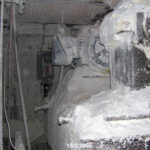Combustible Dust Hazards Increase in the Winter

Combustible dust, such as that created in sawmills, is always a safety hazard that must be properly addressed. (Watch this video to learn more about the hazards of combustible dust.)
But in the winter, the hazards dust poses increase’and some of the safety measures you have in place to control it may not work as well or at all.
That’s why Workplace Safety North recently released a hazard alert based on information from WorkSafeBC about the increased risks posed by dust in the winter.
Why does the colder weather make combustible dust more dangerous’ Because the low humidity levels make dust easy to disperse and ignite. In addition:
- Control measures and clean up practices that rely on the use of water may not be suitable or effective
- Openings such as bay doors and wall dampers may be closed, increasing the degree of enclosure and reducing natural ventilation
- Ventilation may be reduced or shut down to conserve heat
- Re-circulation of air from exhaust systems may also increase
- Portable heating units may introduce additional ignition sources into workspaces.
So now that it’s starting to get colder, employers need to assess for any additional risks associated with the impact of the environment on dust accumulations and the safety measures already in place to control such dust.
For example, implement appropriate dust control measures that take into account the temperature and changes to the workplace operations and conditions.
In addition, if you use space heaters in the workplace, make sure that you comply with any portable heater requirements in your jurisdiction’s OHS laws. For instance, make sure not to locate such heaters in areas containing combustible dust.
And implement proper housekeeping practices for cleaning up dust in the workplace.